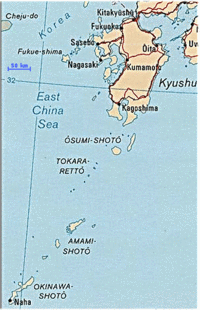Kyushu
Kyushu (Kyūshū, 九州) is one of the principal Japanese islands together with Hokkaido, Honshu and Shikoku. Kyushu is located southwest of the main island Honshu.
F'ukuoka is its most important city. Kumamoto is a major city on Kyushu's west coast with a population of 650,000.
As one of Japan's closest port cities to the Asian mainland, Nagasaki has played a prominent role in foreign trade relations for many centuries and was the most important of only a very few ports open to restricted numbers of foreign traders during Japan's period of isolation.
In August 1945, Nagasaki became the second city after Hiroshima to be destroyed by an atomic bomb. The bomb forced Japan to surrender.
Kyushu is the birthplace of Japanese porcelain.[1]
History
History
Toyotomi Hideyoshi's system of centralized feudalism (Bakuhan) came to Chikugo province in 1573. Tachibana, who had checked the northward advance of the Shimazu clan until Hideyoshi's forces arrived, was enfeoffed with four districts of Chikugo in 1574 as a reward. Hideyoshi supplied considerable support to Tachibana whose power base was initially unstable. Tachibana reciprocated by remaining loyal to Hideyoshi up through the battle of Sekigahara in 1600, participating in the two expeditions to Korea in 1595 and 1598 and becoming Daimyo (lord) of all Chikugo. Tachibana's lands, however, were gradually confiscated over the next 14 years and turned over to Tanaka Yoshimasa. His regime, however, collapsed in 1621.
In 1571, the Japanese government opened a port in Nagasaki for trading with Portuguese ships. After that, many western goods were introduced into Nagasaki.[2]
Industrialization began in the 1860s, with the building of the first cotton textile factory in Kagoshima, Kyushu, in 1867.
One of the biggest battles in world history was planned for Kyushu, with the scheduled American invasion in November, 1945 named "Operation Olympic". With millions of soldiers, sailors and airmen on both sides getting ready, it never happened because Japan surrendered in August.
Thanks to good transport and communications, land availability, local government policy, and labor supply, Kyushu emerged in the 1970s as a major regional concentration of memory chip assembly. In Kumamoto prefecture alone there were 10 of these plants by 1980, the leader of which is Nippon Electric. Using young women as skilled labor, and a highly developed quality control system, the industry became world famous. The research and design work, however, is done in Tokyo.
Bibliography
- Chamberlain, Basil Hall A Handbook for Travellers in Japan (1901) online edition
- Cobbing, Andrew. Kyushu: Gateway to Japan (2008)
- Skates, John Ray. Invasion of Japan: Alternative to the Bomb (2000) excerpt and text search
- Trewartha, Glenn T. Japan: A Geography (1965)
